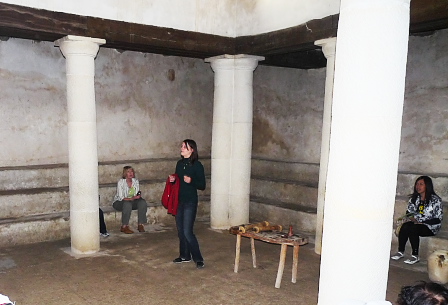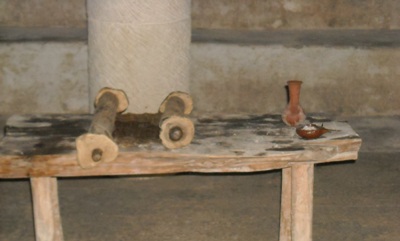|
"Nazareth Village" is a ministry that has attempted to recreate a Galilean farm and village as it would have been at Jesus's Time. It is located very close to where Jesus grew up and is believed to be at the site of a working farm during the Early Roman Period (1st Century BC-AD). The village was recreated using a combination of excavation (such as the wine press), restoration on excavated sites (e.g. the home) and simply building a building similar to ruins found elsewhere (e.g. the synagogue). The official Nazareth Village website of the village gives lots of information about the Archaeology of the site and the reconstruction process. The BiblePlaces site has information about and pictures of Nazareth itself. |
The ![]() symbol
beside some selected pictures indicates a larger image is available by clicking the symbol.
symbol
beside some selected pictures indicates a larger image is available by clicking the symbol.

|

Left: This wine press was carved into the rock. Workers would stomp the grapes in the upper level and the juice would flow down into the lower reservoir to settle. They used their bare feet to avoid breaking the seeds in the grapes and spoiling the wine. Above: It was common for farmers to build their own watch tower to protect their land and crops from undesirable animals and people. Jesus mentioned a watch tower in the parable of the tenants. The land owner built the watch tower in addition to a wall and wine press. (Matthew 21:33 and Mark 12:1.) Sometimes the watch tower included a storage room. |

This was the carpenter shop where some wood working tools of the type that Joseph might have used were demonstrated. |

In a "typical" home, the women demonstrated making yarn. |
|
This home was reconstructed on top of solid rock as explained in the Nazareth Village web site. It really illustrates the parable of the wise man building his house on a rock and the foolish man building on the sand especially when compares building on the rock to building on the shifting desert sand which was subject to flash flooding and windstorms. (See Matthew 7:24-28) The website also discusses the importance of a cornerstone when building a house on a rock. (See I Peter 2:6 and elsewhere). |

|

|

|
Above left and right: This is a recreation of a synagogue originally built elsewhere. Left: This is a scroll sitting on a table in the synagogue. |
Return to the main page Recommended
Previous Next
Last revision: 4/1/2010